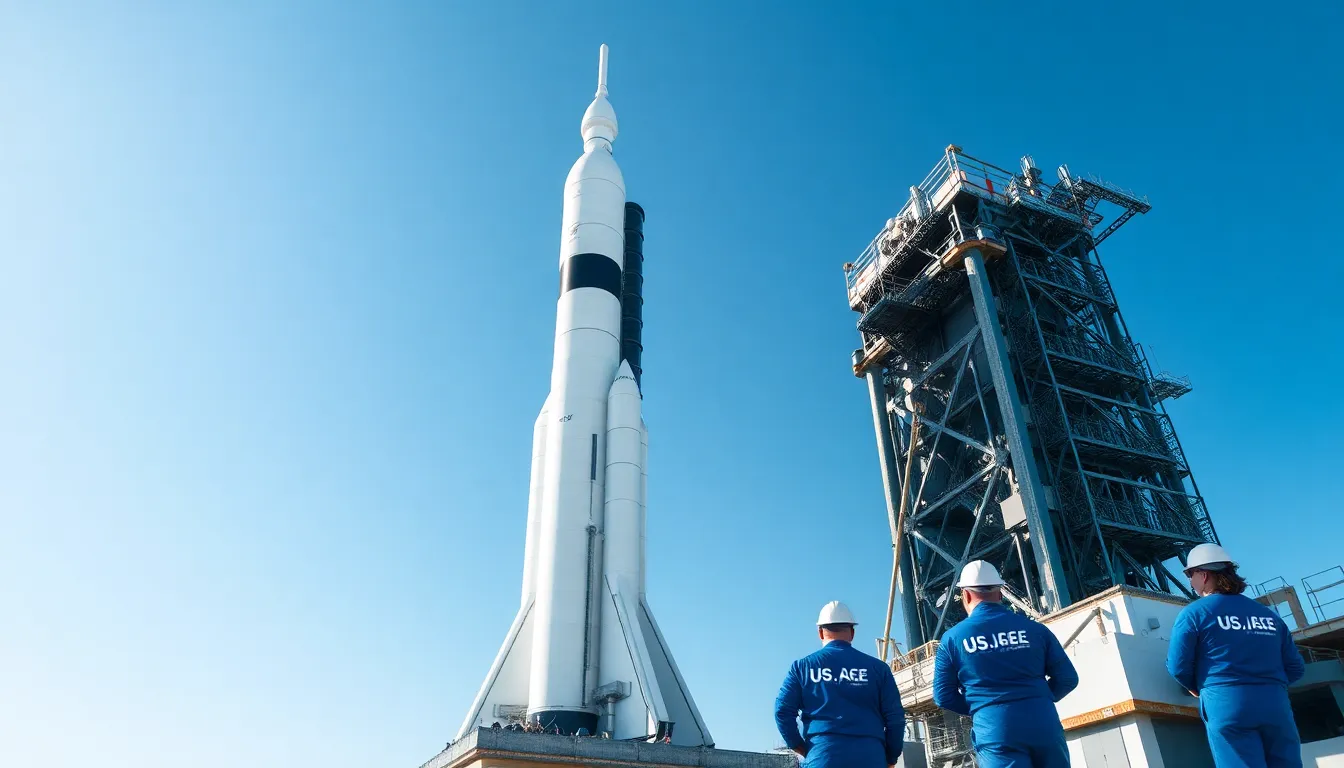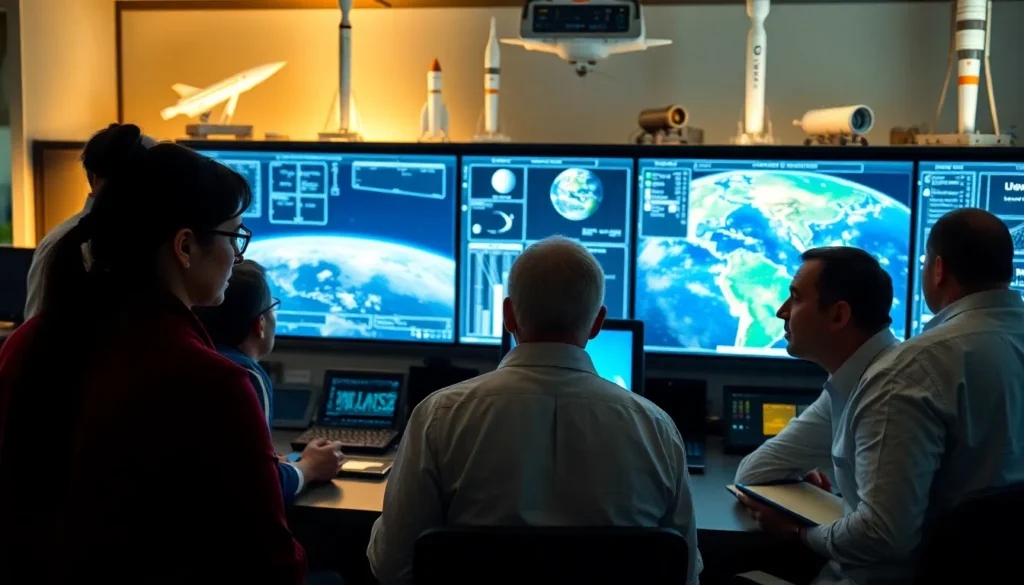Space technology isn’t just for astronauts and sci-fi enthusiasts anymore. It’s the driving force behind innovations that shape our daily lives, from GPS navigation to weather forecasting. Imagine a world where your morning coffee is brewed with data collected from satellites orbiting Earth. Sounds out of this world, right?
Table of Contents
ToggleOverview of Space Technology
Space technology encompasses a wide range of advancements aimed at exploring outer space and improving life on Earth. Satellites, for instance, play a crucial role in various applications like telecommunications, earth observation, and navigation. They provide essential data for global positioning systems, enabling accurate location tracking and route optimization.
Exploration vehicles, including rockets and space shuttles, facilitate missions beyond Earth’s atmosphere. These vehicles transport astronauts and equipment to the International Space Station and other celestial bodies. Research conducted in space enhances scientific understanding of subjects such as climate change and planetary science.
Robotic systems have transformed the capabilities of space exploration. Rovers on Mars and spacecraft orbiting distant planets gather valuable information without human presence. Advancements in artificial intelligence enable these robots to perform complex tasks autonomously.
Communication technology has also evolved due to advancements in space. High-speed internet and mobile communications often rely on satellite networks, expanding connectivity globally. This ensures remote areas gain access to crucial information and educational resources.
Additionally, Earth observation satellites monitor environmental changes, providing data critical for disaster response and management. Insights can inform policy decisions on climate initiatives and resource management.
Space technology fosters international collaboration, bringing together nations to share knowledge and resources. This cooperation enhances innovation, leading to groundbreaking discoveries that benefit humanity as a whole.
Key Innovations in Space Technology

Innovations in space technology continue to revolutionize life on Earth and beyond. Significant advancements in various sectors enhance communication, navigation, and exploration capabilities.
Satellite Technology
Satellite technology plays a crucial role in modern connectivity. Communications satellites enable worldwide telecommunications, facilitating voice and data transfer for billions. Earth observation satellites monitor climate patterns and natural disasters, providing essential data for urban planning and agriculture. Navigation satellites underpin GPS systems, ensuring accurate location services for users globally. These technologies improve logistic operations and enhance everyday convenience in transportation and mapping.
Launch Vehicles
Launch vehicles form the backbone of space missions. These rockets transport payloads, including satellites and scientific instruments, into orbit. Notable examples include SpaceX’s Falcon 9 and NASA’s Space Launch System. Innovations reduce launch costs and improve reliability, enabling more frequent missions. Furthermore, reusable launch systems significantly enhance sustainability in space travel. The evolution of these vehicles supports a growing commercial space sector, fostering private investment and public interest.
Space Exploration Vehicles
Space exploration vehicles expand humanity’s understanding of the universe. Rovers like NASA’s Perseverance gather data on Mars’ geology and search for signs of past life. Autonomous spacecraft, such as the Voyager probes, venture far beyond our solar system, providing invaluable data about distant planets. Advancements in robotic technology enhance these vehicles’ capabilities, reducing risks associated with human presence. The continuous development of exploration vehicles drives scientific discovery and paves the way for future human missions to other celestial bodies.
Applications of Space Technology
Space technology plays a pivotal role in various sectors, offering numerous applications that enhance daily life and scientific knowledge.
Scientific Research
Scientific research benefits significantly from space technology. Satellites gather essential data for climate research, studying atmospheric conditions and monitoring natural disasters. Space missions explore planetary systems, providing insights into the origins of Earth and potential life beyond. Instruments aboard spacecraft conduct experiments in microgravity, revealing new materials and biological processes. Earth and planetary science initiatives rely on precise measurements to understand ecological changes. These advancements collectively contribute to a deeper understanding of fundamental scientific questions.
Communication
Communication relies heavily on advancements in space technology. Satellites facilitate global telecommunications, enabling voice calls, video conferencing, and internet access even in remote areas. Enhanced satellite networks support emergency communications during natural disasters, ensuring critical information reaches affected populations. Communication satellites provide television and radio broadcasting services, connecting diverse audiences across the globe. The integration of space-based networks enhances the speed and reliability of data transmission, fostering international collaboration in business and governance. Overall, satellite technology has transformed how people interact and share information.
Earth Observation
Earth observation transforms the way scientists track environmental changes and manage resources. Satellites monitor land use, deforestation, and urban growth, providing essential insights for urban planning and agriculture. Environmental monitoring instruments detect pollution levels and greenhouse gas emissions, informing climate action policies. Data gathered helps predict natural disasters, enhancing preparedness and response efforts. Organizations utilize satellite imagery for humanitarian efforts, enabling targeted assistance in crisis situations. The accuracy and frequency of observations significantly improve decision-making processes across various fields.
Challenges in Space Technology
Space technology faces significant challenges that can hinder advancements and deployments. These hurdles include funding limitations and complex engineering requirements, both critical for successful missions.
Funding and Budget Constraints
Funding plays a crucial role in the development of space programs. Many projects rely on government allocations and private investments. Budget constraints often lead to delays and scaling back of innovative initiatives. NASA, for example, has experienced fluctuations in its budget, impacting timelines for key missions. In contrast, commercial space companies sometimes face financial pressures that can limit their operational capabilities. Ensuring consistent funding is vital for maintaining momentum in space exploration and technological development.
Technical and Engineering Hurdles
Technical and engineering hurdles present additional challenges in space technology. Designing spacecraft that can withstand extreme conditions requires advanced materials and innovative engineering solutions. Some missions face strict performance criteria, necessitating rigorous testing protocols. Launch vehicle reliability is also a concern, as failures can result in significant financial loss and mission setbacks. Furthermore, integrating various systems, like communications and navigation, demands precise coordination. Addressing these technical obstacles is essential for advancing space missions and ensuring long-term success in exploration initiatives.
The Future of Space Technology
Space technology continues to evolve rapidly, driving progress across multiple fields and promising to revolutionize life on Earth and beyond. Anticipating the future involves understanding emerging trends and the significance of international collaboration.
Emerging Trends
Autonomous systems are becoming increasingly prevalent in space exploration. These robotic systems gather data and perform tasks without human intervention, enhancing mission efficiency. The development of reusable launch vehicles, such as SpaceX’s Falcon 9, significantly reduces costs associated with space travel. Enhanced satellite constellations, like Starlink, are working to provide global internet coverage, bridging connectivity gaps worldwide. Artificial intelligence plays a critical role in data analysis, enabling researchers to process vast amounts of information quickly. Furthermore, advancements in materials science lead to the creation of lightweight yet durable spacecraft, which boosts payload capacity. Investing in these innovative technologies ensures a sustainable future for space exploration.
International Collaboration
Collaborative efforts among countries are transforming the landscape of space technology. Multinational projects, like the International Space Station, illustrate the importance of teamwork in scientific discovery. Partnerships facilitate resource sharing, allowing nations to pool expertise and funding for ambitious missions. Joint ventures in satellite development enhance global communication infrastructures, promoting equity in technology access. Scientific research benefits from diverse perspectives, yielding richer insights into complex problems like climate change. Additionally, joint missions, such as NASA and ESA’s Mars exploration initiatives, showcase the commitment to exploring celestial bodies. These collaborations foster goodwill and create opportunities for shared benefits that transcend national borders.
Space technology is shaping the future in profound ways. Its influence extends beyond scientific discovery to everyday life, enhancing communication, navigation, and environmental monitoring. As advancements continue, the integration of artificial intelligence and autonomous systems will further revolutionize how society interacts with technology.
The collaboration among nations fosters innovation and ensures that benefits are shared globally. With emerging trends like reusable launch vehicles and enhanced satellite networks, the potential for space technology to improve life on Earth and beyond is limitless. As challenges are addressed through international cooperation and investment, the journey into the cosmos promises to yield discoveries that will enrich humanity for generations to come.





